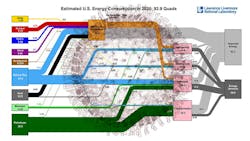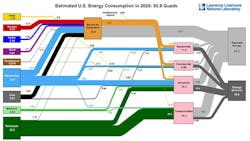Researchers and analysts at the Lawrence Livermore National Laboratory (LLNL) released its latest annual flow chart that tracks the production and consumption of energy in the U.S. Overall, the U.S. used 92.9 quads of energy in 2020, a drop of 7.2 quads (7%) over the year before.
A quad is a quadrillion BTUs, and 3,412 BTUs is equivalent to a kWh. The highest recorded energy use in American history was in 2018, when 101.2 quads were consumed.
Despite the large drop in energy use, wind and solar power saw significant gains, with solar up by 19% and wind up 10%. “Solar and wind continue to show year-on-year growth, which is an impressive change for the energy system,” says A.J. Simon, group leader for Energy at LLNL. “During the pandemic, where total electricity declined only slightly, a lot of coal generation was replaced by renewable energy.”
Use of natural gas was down 2% overall, and 11% in the commercial sector, most likely due to the drop off in commercial activity during the pandemic. Meanwhile, the 7% decline in natural gas use in the residential sector is attributed to a mild winter. These declines were offset by increased use of natural gas in the electricity sector, which (along with renewables) replaced coal consumption.
The pandemic and its associated lockdowns, along with the trend to work from home, led to a 2% increase in electricity use in the residential sector. Conversely, transportation energy use fell 14% due to the lack of travel during the pandemic.
All energy use and conversion results in some losses, shown on the charts as rejected energy. As energy becomes more efficient, rejected energy numbers go down. In 2020, rejected energy dropped 7% from 2019. Still, rejected heat accounted for 62.3 quads, much more than the energy actually used (30.6 quads).
This article appeared in Machine Design.
About the Author
Stephen Mraz
Steve serves as Senior Editor of Machine Design. He has 23 years of service and has a B.S. Biomedical Engineering from Steve was a Flight officer in the U.S. Navy. He is currently responsible for areas such as aerospace and medical.

Leaders relevant to this article:

